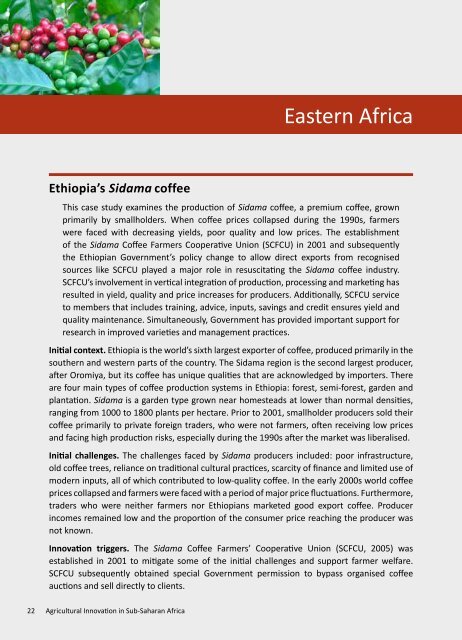1C1KKTs
1C1KKTs
1C1KKTs
Create successful ePaper yourself
Turn your PDF publications into a flip-book with our unique Google optimized e-Paper software.
Eastern Africa<br />
Ethiopia’s Sidama coffee<br />
This case study examines the production of Sidama coffee, a premium coffee, grown<br />
primarily by smallholders. When coffee prices collapsed during the 1990s, farmers<br />
were faced with decreasing yields, poor quality and low prices. The establishment<br />
of the Sidama Coffee Farmers Cooperative Union (SCFCU) in 2001 and subsequently<br />
the Ethiopian Government’s policy change to allow direct exports from recognised<br />
sources like SCFCU played a major role in resuscitating the Sidama coffee industry.<br />
SCFCU’s involvement in vertical integration of production, processing and marketing has<br />
resulted in yield, quality and price increases for producers. Additionally, SCFCU service<br />
to members that includes training, advice, inputs, savings and credit ensures yield and<br />
quality maintenance. Simultaneously, Government has provided important support for<br />
research in improved varieties and management practices.<br />
Initial context. Ethiopia is the world’s sixth largest exporter of coffee, produced primarily in the<br />
southern and western parts of the country. The Sidama region is the second largest producer,<br />
after Oromiya, but its coffee has unique qualities that are acknowledged by importers. There<br />
are four main types of coffee production systems in Ethiopia: forest, semi-forest, garden and<br />
plantation. Sidama is a garden type grown near homesteads at lower than normal densities,<br />
ranging from 1000 to 1800 plants per hectare. Prior to 2001, smallholder producers sold their<br />
coffee primarily to private foreign traders, who were not farmers, often receiving low prices<br />
and facing high production risks, especially during the 1990s after the market was liberalised.<br />
Initial challenges. The challenges faced by Sidama producers included: poor infrastructure,<br />
old coffee trees, reliance on traditional cultural practices, scarcity of finance and limited use of<br />
modern inputs, all of which contributed to low-quality coffee. In the early 2000s world coffee<br />
prices collapsed and farmers were faced with a period of major price fluctuations. Furthermore,<br />
traders who were neither farmers nor Ethiopians marketed good export coffee. Producer<br />
incomes remained low and the proportion of the consumer price reaching the producer was<br />
not known.<br />
Innovation triggers. The Sidama Coffee Farmers’ Cooperative Union (SCFCU, 2005) was<br />
established in 2001 to mitigate some of the initial challenges and support farmer welfare.<br />
SCFCU subsequently obtained special Government permission to bypass organised coffee<br />
auctions and sell directly to clients.<br />
22 Agricultural Innovation in Sub-Saharan Africa


